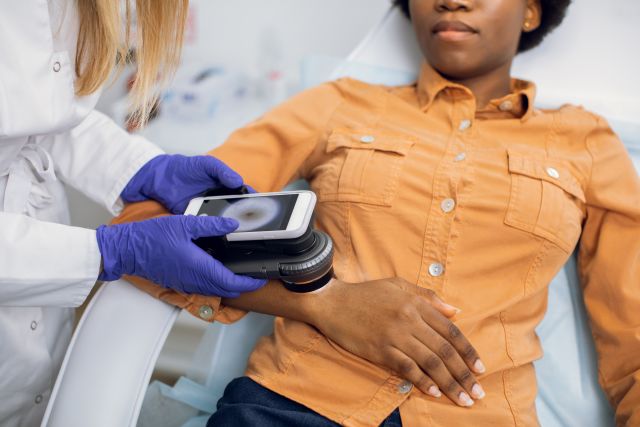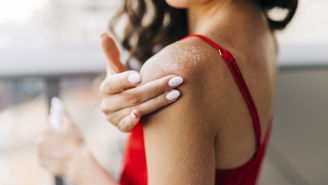Updated on March 17, 2023.
Are you keeping an eye on your skin? If you don’t regularly scan for new growths or spots that are changing in appearance, it’s time to get into the habit.
One in five Americans will have skin cancer by age 70. It’s not only found in older people, though. In fact, melanoma—the rarest but most dangerous form of skin cancer—is one of the most common cancers in people under 30.
Upwards of 53 percent of cases of melanoma are discovered through self-examination, according to a 2016 study published in the Journal of the American Academy of Dermatology. And as many as 40 percent of recurring cases of melanoma are found in this way as well, per a 2017 study published in the Journal of the American College of Surgeons. Because melanoma becomes more dangerous the thicker it grows above and below the skin’s surface, early detection is essential to survival.
The good news is that skin cancer is highly curable as long as it’s discovered in the early stages.
Understanding skin cancer types
Skin cancer starts in the epidermis, the part of the skin you can see. It can appear on any part of the body.
In white people, skin cancer is often found on areas that are most often exposed to the sun, such as the face, neck, hands, and arms. For people of color (including people of African, Asian, Latino, Mediterranean, Middle Eastern, and Native American descent), cancerous spots often appear in areas that aren’t exposed to the sun. These include the soles of the feet, palms of the hands, groin, or even in the mouth. In many cases, these spots can be difficult to detect, which may lead to later diagnoses.
Here’s what to know about the various types of skin cancer and what to look for when you examine your skin:
Basal cell carcinoma
This form of skin cancer originates in the bottom layer of the epidermis (also known as the basal layer). These cancers are slow-growing and rarely spread to other parts of the body. Basal cell carcinoma is considered a less dangerous form of skin cancer than squamous cell carcinoma and melanoma (below). But inadequately treated tumors can cause considerable damage over time.
Incidence: Approximately 80 percent of all skin cancers are basal cell carcinomas. There is an 85 to 90 percent cure rate, depending on the type of treatment. It is the most common type of skin cancer overall and the second-most common type among Black people.
Appearance: On white and light skin, it often appears as a flat, scaly growth that is red, pink, or white, or as a small, raised bump that is shiny or waxy. It may also have a crusty texture or involve an open sore that has not healed or that heals only temporarily. On brown or black skin, it may appear brown or glossy black with small blood vessels on the surface. Occasionally, it appears as an ulceration (an open sore).
Squamous cell carcinoma
This skin cancer originates in the upper part of the epidermis. These cancers are more likely than basal cell carcinomas to spread to tissues beneath the skin. And unlike basal cell carcinomas, squamous cell carcinomas can metastasize (or spread to other parts of the body), although it is rare for this to happen.
Incidence: Squamous cell carcinoma accounts for just under 20 percent of all skin cancers. It is the second most common type of skin cancer overall and the most common type among Black people.
About 2,000 people in the United States die from both squamous and basal cell cancer each year, according to the American Cancer Society (ACS). When properly treated, however, squamous cell carcinomas have a 95 percent cure rate.
Appearance: Among people with black or brown skin, squamous cell carcinoma often appears on the lower body and can present as an open sore or as a raised growth or wart-like growth. On white skin, it often appears as a growing lump with a rough surface or as a flat, reddish, scaly patch that grows slowly.
Melanoma
Melanoma begins in the melanocytes, the cells of the skin responsible for producing pigment (melanin). Because malignant melanomas tend to spread, early detection and treatment is essential.
Incidence: Although it’s the rarest form of skin cancer, accounting for only about 1 percent of skin cancers, it causes the majority of skin cancer deaths—and cases are on the rise.
According to the ACS, about 97,610 new cases are expected to be diagnosed in 2023 with almost 8,000 deaths. Men are more likely than women to be diagnosed with melanoma, but the rate of occurrence in women over age 50 has steadily been rising. White people are 20 times more likely to have melanoma than Black or Hispanic people. That said, Black people have a lower survival rate, in large part because it’s more often diagnosed in later stages of the disease than it is in white patients.
For example, melanoma tends to occur in people of color on parts of the body that are less exposed to the sun, such as the soles of the feet, the hands, or under the nails, making detection more difficult. What’s more, because it’s less common among people of color, healthcare providers (HCPs) may make regular, full-body skin checks less of a priority for patients of color than they do for white patients.
Appearance: In about 30 percent of cases, melanoma develops from or near a mole. A mole is a common type of skin growth that typically appears as a small, dark spot. Moles form when melanocytes cluster together.
For the most part, melanomas typically appear in otherwise normal-looking skin. Spots typically appear to be brown or black but may also be pink or red and may resemble warts, sores, or fungus.
Know how to track signs of melanoma
It’s important to scan your skin at least once a month for any spots on your skin that are new, unusual, or changing, whether on skin exposed to the sun or on skin that’s usually protected from the sun. Remembering "ABCDE" can help track the signs of melanoma and differentiate spots of concern from typical moles:
- Asymmetry: A misshapen spot with one half that doesn't match the other half is a sign of melanoma. (Moles, on the other hand, are usually symmetrical.)
- Border: While moles typically have smooth, even borders, the edges of melanomas tend to be ragged or uneven.
- Color: The pigmentation of melanomas is typically not uniform. They may appear with different shades of tan, brown, or black, and may also include red, white, or blue. (Moles usually appear as a single shade of brown.)
- Diameter: While melanomas may appear at any size, a warning sign is a spot with a diameter larger than ¼ of an inch (or 6 millimeters, about the size of a pencil eraser).
- Evolving: Keep an eye out for any spot that changes in color, size, shape, or elevation—or that that begins to itch, crust, or bleed.
Any number of these traits may indicate melanoma and should be checked out right away by an HCP.
How to scan your skin in 7 steps
Start your own skin-scanning routine by getting to know what's typical for you. The better you know your skin, the more likely you'll be able to notice changes. Learn where your birthmarks, freckles, moles, and blemishes are and what they usually look and feel like.
You'll need a well-lit room with a full-length mirror and a hand mirror. A blow dryer may also come in handy. The bathroom is generally a good location. It may also help to do your skin exam with a partner. Here’s how to start:
- Look at the front and back of your body in a mirror.
- Look at your left and right sides. Raise your arms and bend your elbows.
- Look at your underarms, forearms, the backs of your upper arms, and your palms.
- Sit down and look at the back of your legs and feet, the spaces between your toes, and the soles of your feet.
- Use a mirror to examine the back of your neck and scalp. Using a blow dryer on a low setting may help move your hair out of the way to examine your entire scalp.
- Use a hand mirror to examine your back and your buttocks.
- Finally, take photographs of any unusual skin marks. The next time you scan your skin, check these spots against your photos to see if they have changed in any way.
Be alert for changes
Changes in existing moles or blemishes, especially if they are getting larger, may indicate cancerous cells. If you find changes when you are examining your skin, make an appointment to speak with an HCP. Not all skin cancers look the same and changes in the skin are not sure signs of cancer. But there are a few symptoms common to the three major types of skin cancer:
- The development of any new colored growth
- A spot or bump that has been getting larger or has changed texture or color
- A sore that has not healed within 3 months
Many experts also recommend getting a routine professional examination once a year to screen for skin cancer. Speak to your HCP about your risk factors and discuss whether setting up a regular routine of exams with a dermatologist may make sense for you.
What else could it be?
It can often be hard to tell cancerous skin conditions from noncancerous ones. The skin conditions below are noncancerous, but an HCP's expert eye is needed for diagnosis:
- Actinic keratosis: Thick, rough, scaly patches of skin that are typically red or brown in color
- Cherry angiomas: Small, smooth, skin growths that often appear as a cherry-red bump
- Sebaceous hyperplasia: Common, benign, round, flesh-colored or yellow lesions, usually found on the face
- Seborrheic keratosis: Benign lesions that vary in color from pink to light tan to black, often found on the chest or back
- Dermatofibroma: Small hard lumps typically found on the arms and lower legs that are pink, red, or brown and may be tender or itchy
- Hemangioma: Red or purple lumps caused by blood vessel buildup
- Lipoma: Soft rubbery growth in the subcutaneous tissue (just below the skin)
- Keratinous and pilar cysts: Lumps beneath the skin made of built-up protein
Skin cancer is more common than any other cancer, and the number of people being diagnosed with skin cancer is increasing each year. But unlike almost any other type of cancer, all forms of skin cancer are detectable and curable in their early stages and there are a variety of treatment options available. The key is to learn to spot the early signs and to make a regular habit of looking for them.
Learn more about treatments for basal cell carcinoma, squamous cell carcinoma, and melanoma.







